Chapter: Computer Networks : Physical Layer
Networks
Networks:
A network is a set of devices (often
referred to as nodes) connected by communication links. A node can be a
computer, printer, or any other device capable of sending and/or receiving data
generated by other nodes on the network.
1. Distributed Processing:
Most
networks use distributed processing, in which a task is divided among multiple
computers. Instead of one single large machine being responsible for all
aspects of process, separate computers (usually a personal computer or workstation)
handle a subset.
2. Network Criteria:
A network
must be able to meet a certain number of criteria. The most important of these
are performance, reliability, and security.
a. Performance: Performance can be measured in
many ways, including transit timeand response time.
Transit
time is the amount of time required for a message to travel from one device to
another. Response time is the elapsed time between an inquiry and a response.
The
performance of a network depends on a number of factors, including the number
of users, the type of transmission medium, the capabilities of the connected
hardware, and the efficiency of the software.
b. Reliability: In addition to accuracy of
delivery, network reliability is measured by thefrequency of failure, the time
it takes a link to recover from a failure, and the network's robustness in a
disaster.
c. Security: Network security issues include
protecting data from unauthorized access,protecting data from damage and
development, and implementing policies and procedures for recovery from
breaches and data losses.
3. Physical Structures:
Type of
Connection: A network is two or more devices connected through
links. A linkis a communications pathway that transfers data from one device to
another.
There are
two possible types of connections: point-to-point and multipoint.
a. Point-to-Point: A
point-to-point connection provides a dedicated link between twodevices. The
entire capacity of the link is reserved for transmission between those two
devices (see Figure 1.3a).
b. Multipoint: A multipoint (also called
multidrop) connection is one in which more thantwo specific devices share a
single link (see Figure 1.3b). In a multipoint environment, the capacity of the
channel is shared, either spatially or temporally. If several devices can use
the link simultaneously, it is a spatially shared connection. If users must
take turns, it is a timeshared connection.
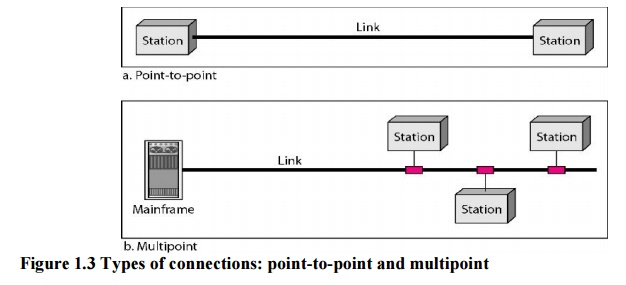
Physical Topology:
The term
physical topology refers to the way in which a network is laid out physically.
Two or more devices connect to a link; two or more links form a topology. The
topology of a network is the geometric representation of the relationship of
all the links and linking devices (usually called nodes) to one another.
There are
four basic topologies possible: mesh, star, bus, and ring (see Figure 1.4)

a. Mesh: In a mesh topology, every device
has a dedicated point-to-point link to every otherdevice. A fully connected
mesh network with n nodes has n(n -1) /2 physical channels.
To
accommodate that many links, every device on the network must have n – 1
input/output (I/O) ports (see Figure 1.5) to be connected to the other n – 1
stations.
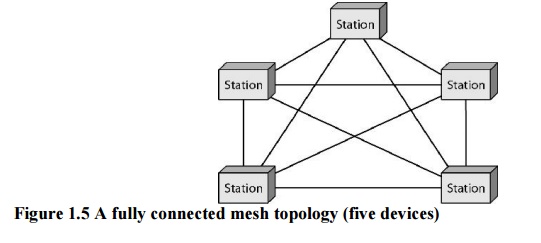
1.
The use of dedicated links guarantees that each connection
can carry its own data load, thus eliminating the traffic problems that can
occur when links must be shared by multiple devices.
2.
A mesh topology is robust. If one link becomes
unusable, it does not incapacitate the entire system.
3.
Privacy or security.
4.
Point-to-point links make fault identification and
fault isolation easy.
Disadvantages:
1.
Every device must be connected to every other
device, installation and reconnection are difficult.
2.
The sheer bulk of the wiring can be greater than
the available space (in walls, ceilings, or floors) can accommodate.
3.
The hardware required to connect each link (I/O
ports and cable) can be prohibitively expensive.
One
practical example of a mesh topology is the connection of telephone regional
offices in which each regional office needs to be connected to every other
regional office.
b. Star Topology: In a star topology, each device
has a dedicated point-to-point link only to acentral controller, usually called
a hub. The devices are not directly linked to one another. Unlike a mesh
topology, A star topology does not allow direct traffic between devices. The
controller acts as an exchange: If one device wants to send data to another, it
sends the data to the controller, which then relays the data to the other connected
device (see Figure 1.6).
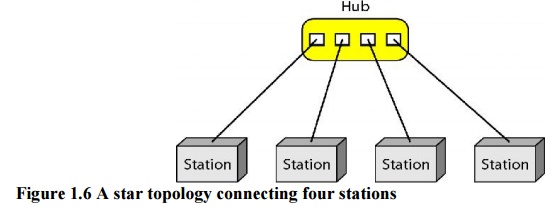
Advantages:
1.
Less expensive than a mesh topology.
2.
Easy to install and reconfigure.
3.
Far less cabling needs to be housed, and additions,
moves, and deletions involve only one connection: between that device and the hub.
4.
It includes Robustness. If one link fails, only
that link is affected. All other links remain active.
Disadvantages:
1.
It is the dependency of the whole topology on one
single point, the hub. If the hub goes down, the whole system is dead.
2.
A star requires far less cable than a mesh; each
node must be linked to a central hub. For this reason, often more cabling is
required in a star than in some other topologies (such as ring or bus).
The star
topology is used in local-area networks (LANs). High-speed LANs often use a
star topology with a central hub.
c. Bus Topology: A bus topology is multipoint.
One long cable acts as a backbone to link allthe devices in a network (see
Figure 1.7). Nodes are connected to the bus cable by drop lines and taps.
A drop
line is a connection running between the device and the main cable.
A tap is
a connector that either splices into the main cable or punctures the sheathing
of a cable to create a contact with the metallic core. As a signal travels
along the backbone, some of its energy is transformed into heat. Therefore, it
becomes weaker and weaker as it travels farther and farther. For this reason
there is a limit on the number of taps a bus can support and on the distance
between those taps.

Advantages:
1.
Ease of installation.
2.
Less cabling
Disadvantages:
1.
Difficult reconfiguration and fault isolation.
2.
Difficult to add new devices.
3.
Signal reflection at top can degradation in
quality.
4.
If any fault in backbone can stops all
transmission.
Ethernet
LANs can use a bus topology, but they are less popular now.
d. Ring Topology: In a ring
topology, each device has a dedicated point-to-point connectionwith only the
two devices on either side of it. A signal is passed along the ring in one
direction, from device to device, until it reaches its destination. Each device
in the ring incorporates a repeater. When a device receives a signal intended
for another device, its repeater regenerates the bits and passes along them
(see Figure 1.8).
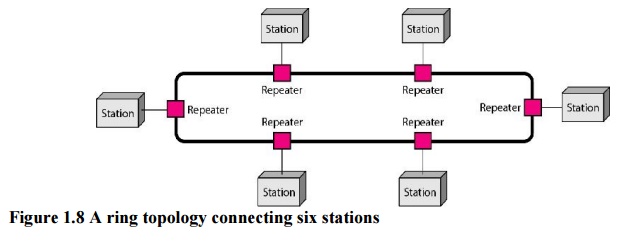
1.
Easy to install.
2.
Easy to reconfigure.
3.
Fault identification is easy.
Disadvantages:
1.
Unidirectional traffic.
2.
Break in a single ring can break entire network.
Ring
topologies are found in some office buildings or school campuses. Today high
speed LANs made this topology less popular.
e. Hybrid Topology: A network
can be hybrid. For example, we can have a main star topologywith each branch
connecting several stations in a bus topology as shown in Figure 1.9.

4. Network models:
Computer
networks are created by different entities. Standards are needed so that these heterogeneous
networks can communicate with one another. The two best-known standards are the
OSI model and the Internet model.
1. The OSI
(Open Systems Interconnection) model defines a seven-layer network.
2. The
Internet model defines a five-layer network.
5. Categories of Networks:
Networks
are generally referring to two primary categories: local-area networks and
wide-area networks.
A LAN
normally covers an area less than 2 Meters. A WAN can be worldwide.
Networks
of a size in between are normally referred to as metropolitan area networks and
span tens of miles.
a. Local Area Network:
A local
area network (LAN) is usually privately owned and links the devices in a single
office, building, or campus (see Figure 1.10). Depending on the needs of an
organization and the type of technology used, a LAN can be as simple as two PCs
and a printer in someone's home office; or it can extend throughout a company
and include audio and video peripherals. Currently, LAN size is limited to a
few kilometers
LANs are
designed to allow resources to be shared between personal computers or
workstations. The resources to be shared can include hardware (e.g., a
printer), software (e.g., an application program) or data. LANs are
distinguished from other types of networks by their transmission media and
topology. In general, a given LAN will use only one type of transmission
medium. The most common LAN topologies are bus, ring, and star. Early LANs had
data rates in the 4 to 16 megabits per second (Mbps) range. Today, however,
speeds are normally 100 or 1000 Mbps.
Wireless
LANs are the newest evolution in LAN technology.
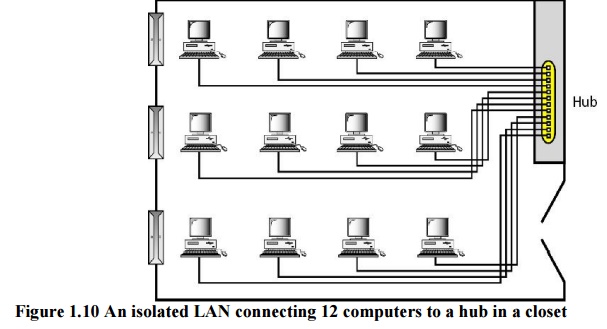
b. Wide Area Network
A wide
area network (WAN) provides long-distance transmission of data, image, audio
and video information over large geographic areas that may comprise a country,
a continent or even the whole world. A WAN can be as complex as the backbones
that connect the Internet or as simple as a dial-up line that connects a home
computer to the Internet. We normally refer to the first as a switched WAN and
to the second as a point-to-point WAN (Figure 1.11).
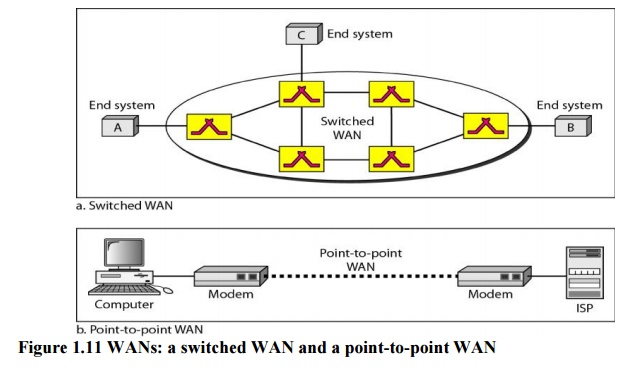
The
switched WAN connects the end systems, which usually comprise a router
(internetworking connecting device) that connects to another LAN or WAN. The
point-to-point WAN is normally a line leased from a telephone or cable TV
provider that connects a home computer or a small LAN to an Internet service
provider (lSP). This type of WAN is often used to provide Internet access.
An early
example of a switched WAN is X.25, a network designed to provide connectivity
between end users. X.25 is being gradually replaced by a high-speed, more
efficient network called Frame Relay. A good example of a switched WAN is the
asynchronous transfer mode (ATM) network, which is a network with fixed-size
data unit packets called cells. Another example of WANs is the wireless WAN
that is becoming more and more popular.
e. Metropolitan Area Networks:
A
metropolitan area network (MAN) is a network with a size between a LAN and a
WAN. It
normally covers the area inside a town or a city. It is designed for customers
who need a high-speed connectivity, normally to the Internet, and have
endpoints spread over a city or part of city. A good example of a MAN is the
part of the telephone company network that can provide a high-speed DSL line to
the customer.
6. Interconnection of Networks : Interconnect
When two
or more networks are connected, they become an internetwork, or internet. As an
example, assume that an organization has two offices, one on the east coast and
the other on the west coast. The established office on the west coast has a bus
topology LAN; the newly opened office on the east coast has a star topology
LAN. The president of the company lives somewhere in the middle and needs to
have control over the company from her horne.

To create a backbone WAN for connecting these three entities (two LANs
and the president's computer), a switched WAN (operated by a service provider
such as a telecom company) has been leased. To connect the LANs to this
switched WAN, however, three point-to-point WANs are required. These
point-to-point WANs can be a high-speed DSL line offered by a telephone company
or a cable modern line offered by a cable TV provider as shown in Figure 1.12.
Related Topics